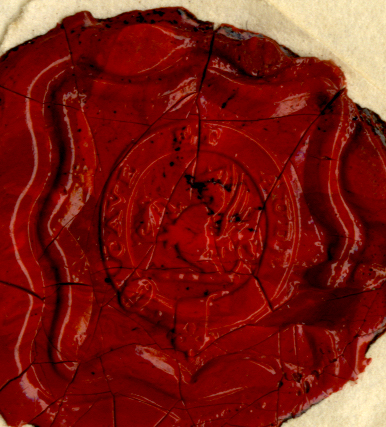Darwin's Seal
An introduction by Angus Carroll
In a letter dated October 24th, 1839, Charles Darwin wrote to his cousin William Darwin Fox, asking if he knew "what the motto to our crest is for I mean to have a seal solemnly engraved." [1] Which, evidently, he did—a letter from Darwin to the Reverend Gilbert Smith dated November 20th, 1840, sports a seal featuring his family crest and motto.
The seal on the 1840 letter to Rev'd Smith. (Click the image for higher resolution.)

The Darwin Coat-of-Arms. The Crest is above the shield.
The seal, impressed in red wax, shows a griffin, facing left, holding a shell, all within an oval border inscribed with the motto Cave et Aude, which, according to Fairbairn, means Beware and Dare. [2] This is the crest at the top of the Darwin coat-of-arms (which has a shield with three shells diagonal and the motto at the bottom). Darwin's seal is rare—he wrote thousands of letters after 1840, but no other is described as having the seal. It is possible Darwin had the seal made in a fit of youthful enthusiasm, used it for a short period of time and then stopped, realizing it was a bit ostentatious. A simpler explanation: He lost it. [3] See images of the letter here.
Interestingly, the motto was not always Cave et Aude. In the late 18th century, Darwin's grandfather Erasmus changed the motto to E Conchis Omnia (Everything from shells), reflecting his belief that all life descended from one simple form, a concept he put forward in his Zoonomia (1794):
"Would it be too bold to imagine, that in the great length of time, since the earth began to exist, perhaps millions of ages before the commencement of the history of mankind, would it be too bold to imagine, that all warm-blooded animals have arisen from one living filament, which THE GREAT FIRST CAUSE endued with animality, with the power of acquiring new parts, attended with new propensities, directed by irritations, sensations, volitions, and associations; and thus possessing the faculty of continuing to improve by its own inherent activity, and of delivering down those improvements by generation to its posterity, world without end!" [4]

Erasmus Darwin's bookplate with his new motto, E Conchis Omnia.
Erasmus not only put the new motto on his bookplate, he put it on the side of his carriage. Unfortunately, Thomas Seward, [5] who was Canon of nearby Lichfield Cathedral, noticed it and accused Erasmus of having "renounced his Creator." He wrote a satirical poem about Erasmus, part of which read:
Great wizard he! By magic spells
Can all things raise from cockle shells.
Having been called out by the Canon, Erasmus painted over the motto on his carriage to avoid offending his clients. Nevertheless, he kept it on his bookplate, as did his son, Robert Waring Darwin, Charles' father. Thus, Charles grew up in a house where all the books carried an evolutionary declaration. [6]
Charles, however, used the original motto when he had his seal made, even though by then (1840) he had read Malthus and was an evolutionist himself. It may be he had forgotten (or never noticed) Erasmus' version, and went on whatever Fox told him, probably the original. In any case, both suit Darwin well, for if not Everything from Shells, Beware and Dare nicely sums up Darwin's career: He went cautiously, weighing the evidence slowly, but when he was sure, he turned the world on its head.
Darwin, C. R. 1840. Autograph letter to Rev. Smith with wax seal. Text & images
Footnotes:
[1] Darwin to G. N. Smith 20 November [1840]. Correspondence vol. 24.
[2] Fairbairn's Book of Crests of the Families of Great Britain & Ireland, c1860.
[3] Of course, he may very well have continued to use the seal. Most of Darwin's later correspondence was on stationery and mailed in envelopes, most of which were discarded taking any seals with them. Thus the rarity of his seal may be due to the introduction of the "envelope" in 1840.
[4] Zoonomia, vol. 1, p. 505.
Darwin, Erasmus. 1794-1796. Zoonomia: or, the laws of organic life. 2 vols. London: J. Johnson, CUL-CCA.24.58-59 (possibly Francis Darwin's). CUL-DAR.LIB.138. vol. 1. PDF vol. 2. PDF
[5] His daughter, Anna Seward, would later write a biography of Erasmus: Seward, Anna. 1804. Memoirs of the Life of Dr. Darwin: Chiefly During His Residence in Lichfield, with anedcotes of his friends, and criticisms on his writings. London: J. Johnson. [signed][Darwin Library-Down] PDF
[6] Charles Darwin's The life of Erasmus Darwin, edited by Desmond King-Hele, 2002, p. xiii.






